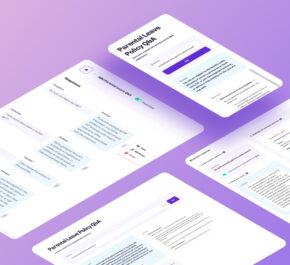Automating legal advice
Here at Josef, our mission is to make legal services more accessible, and we do this by empowering our users to build better bots.
Of the thousands of bots we’ve seen, many of our favourites automate the provision of legal guidance and advice. But, how can legal professionals make sure they do this well?
What are legal advice bots?
Legal advice bots automate the provision of legal information and advice to users. They take complex legal conditions and processes and break them down into pieces, steps and questions that are relevant to the user.
For example, a client may not know if a regulation applies to them, or if they’re eligible for a particular scheme. A legal advice bot would ask questions about their circumstances and guide them to the right answer.
Legal advice bots are used for many purposes, largely depending on the type of legal team that builds it!
Who uses them?
All types of legal teams, firms and practices use legal advice bots.
Community legal centres and other not-for-profit organisations use legal advice bots to help them serve more clients, helping the largest number of people with common and repeatable legal problems.
In-house teams often use legal advice bots to automate answers to FAQs, optimising their team’s time for complex enquiries and giving their internal and external stakeholders a method to self-serve for everyday enquiries.
Law firms – large to small – and sole practitioners use legal advice bots to improve the client experience, increase the number and quality of client leads or for internal knowledge management purposes.
In many cases, by giving clients a useful tool that answers simpler questions, prospects and clients are more likely to pick up the phone and engage a legal professional.
Here are our top four tips for builders to ensure your legal advice bot does what it’s meant to, manages enquiries effectively, and frees up your day.
1. Pick the right problem
Focus on solving a problem that is strategically important for your team, and valuable for your bot’s users.
Whether helping your bot’s users make a decision or guiding them through legal steps, the biggest efficiency gains come from automating the easy questions you get asked a lot.
For in-house teams, that looks like focusing on automating frequently asked questions. For a law firm, that looks like identifying common queries that you generally don’t charge for or that sit alongside other reimbursed work.
2. Keep it simple
When it comes to legal advice, don’t overcomplicate!
Focus on doing one thing really well, rather than lots of things moderately well. Some of the most effective legal advice bots we’ve seen solve a single legal problem.
Also, most users have short attention spans, so focus on building your bot so it gathers information quickly and efficiently, so you can offer relevant advice and guidance.

Legal advice bots are a building block to help teams scale
3. Process, process process
In legal advice bots, there is usually at least one handover point – from bot to person, bot to database, bot to document – so thinking about the process is essential.
To deliver a good overall experience, it’s important the bot works with your existing service model, rather than working against it. Consider things like:
- What happens if a user has a new request, or a question that isn’t addressed by the bot?
- If it’s an external legal advice bot, how will your existing or new clients find and access it?
Thinking about these questions will help your bot fit in with your systems, your processes and your team.
4. Don’t set and forget!
The best legal advice bots are regularly reviewed and improved by their builders.
Getting input from your intended users on what they want at the start is time well spent. Listening and iterating on your users feedback, whether at launch or in a dedicated prototyping process, is a step that shouldn’t be overlooked.
It’s always recommended to keep an open mind to new ideas and improvements, and talk to your users.
By staying connected with your users and asking for (and listening to) feedback, you can both improve your bot and build better bots!
Have you got legal advice you’d like to automate? We’d love to hear from you!
If you have a question or would like to learn more, contact us here:
Thanks for requesting a demo!
We'll be in touch soon to arrange a time to speak.



